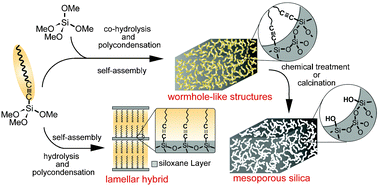Silica-based nanomaterials with lamellar and wormhole-like mesostructures were prepared via self-assembly processes using 1-alkynyltrimethoxysilanes (CH3(CH2)n−3C![[triple bond, length as m-dash]](https://www.rsc.org/images/entities/char_e002.gif) CSi(OCH3)3; 1Cn, n = 10, 16) containing a C–C triple bond adjacent to the silicon atom. Hydrolysis and polycondensation of 1C10 afforded a viscous paste, whereas 1C16 formed a lamellar hybrid consisting of siloxane layers and bilayers of alkynyl groups. Wormhole-like mesostructures were formed by co-hydrolysis and polycondensation of 1Cn and tetramethoxysilane (TMOS) followed by evaporation of solvents at room temperature for n = 10 and at 50 °C for n = 16. Removal of alkynyl groups from the wormhole-like mesostructures either by chemical treatment using fluoride ions or by calcination afforded mesoporous silica with three-dimensional pore-connectivity. This procedure affords one of the synthetic pathways to prepare mesoporous silica without surfactants as templates. The N2 adsorption data revealed that the chemically treated products had larger pore diameters and pore volumes than those of the calcined products. The pore diameter and the pore wall thickness were controlled by changing the alkynyl chain length and the TMOS/1Cn molar ratio, respectively. Furthermore, transparent thin films of a wormhole-like mesostructure could be prepared from a 1C10–TMOS or 1C10–1C16–TMOS system, although only a lamellar thin film was obtained from a 1C16–TMOS system.
CSi(OCH3)3; 1Cn, n = 10, 16) containing a C–C triple bond adjacent to the silicon atom. Hydrolysis and polycondensation of 1C10 afforded a viscous paste, whereas 1C16 formed a lamellar hybrid consisting of siloxane layers and bilayers of alkynyl groups. Wormhole-like mesostructures were formed by co-hydrolysis and polycondensation of 1Cn and tetramethoxysilane (TMOS) followed by evaporation of solvents at room temperature for n = 10 and at 50 °C for n = 16. Removal of alkynyl groups from the wormhole-like mesostructures either by chemical treatment using fluoride ions or by calcination afforded mesoporous silica with three-dimensional pore-connectivity. This procedure affords one of the synthetic pathways to prepare mesoporous silica without surfactants as templates. The N2 adsorption data revealed that the chemically treated products had larger pore diameters and pore volumes than those of the calcined products. The pore diameter and the pore wall thickness were controlled by changing the alkynyl chain length and the TMOS/1Cn molar ratio, respectively. Furthermore, transparent thin films of a wormhole-like mesostructure could be prepared from a 1C10–TMOS or 1C10–1C16–TMOS system, although only a lamellar thin film was obtained from a 1C16–TMOS system.

You have access to this article
 Please wait while we load your content...
Something went wrong. Try again?
Please wait while we load your content...
Something went wrong. Try again?
![[triple bond, length as m-dash]](https://www.rsc.org/images/entities/char_e002.gif) CSi(OCH3)3; 1Cn, n = 10, 16) containing a C–C triple bond adjacent to the silicon atom.
CSi(OCH3)3; 1Cn, n = 10, 16) containing a C–C triple bond adjacent to the silicon atom. 

 Please wait while we load your content...
Please wait while we load your content...